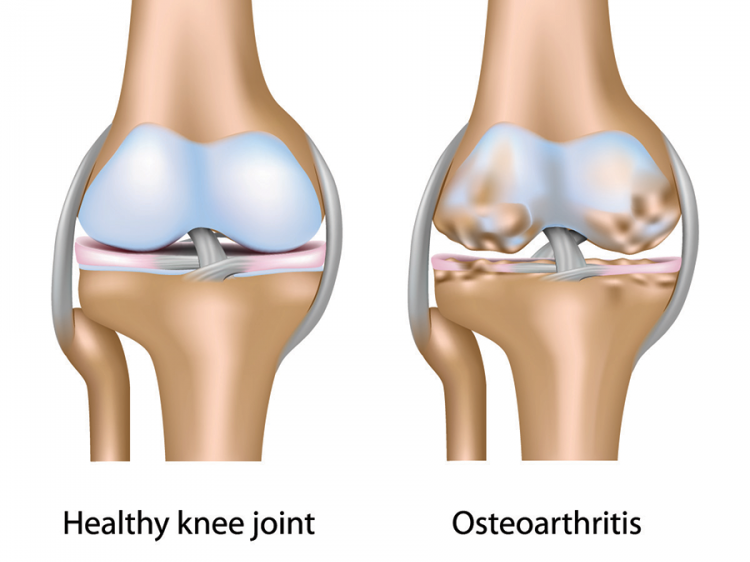Ayurveda for Osteoarthritis

Osteoarthritis is a degenerative joint disease and one of the most common types of Arthritis, often occurring with patients after the age of 50. Osteoarthritis (OA) is caused by the degeneration of the cartilage. Cartilage is the firm, rubbery tissue that cushions bones at joints. Healthy cartilage allows smooth movement of joints enabling bones to glide over one another, acting like a shock absorber by absorbing energy from the shock of physical movements. In case of OA, the cartilage breaks down resulting in rubbing of the bones together causing pain, swelling, and stiffness. Osteoarthritis can affect any joints but the most commonly affected joints are hand, knee, hip and spine.
In Ayurveda, Osteoarthritis occurs due to aggravation of Vata Dosha and is known as ‘Sandhigata Vata’. It is one of the Vata vyadhi where the aggravated vata lodges in the joints causing swelling. Because Vata is dry in nature, it absorbs all the lubrication in the joints leading to swelling, pain and crepitation sound at the time of movement. It also causes destruction of the cartilages and reduction in the Synovial Fluid inside the joint capsule. The swollen joint when palpated feels as if one is touching air filled bladder.
Cause of Sandhigata Vata:
Hereditary and old age are the most common cause. Consumption of dry, cold, stale, astringent, bitter food, exposing oneself to dry, cold climate, excessive use of joints, injury to joints and obesity are some of the major causes of Sandhigata Vata or Osteoarthritis.
Symptoms:
- Pain in the joints is the first symptom. The intensity of pain may vary from mild to severe.
- Stiffness of the joints may be observed especially after prolonged rest of the affected joint.
- Crepitation or cracking sound is heard from the joints at the time of movement and there is swelling of the affected joints.
- Restricted movement is observed or range of movement decreases.
Ayurvedic Treatment for Osteoarthritis:
Ayurveda used Vata-alleviating treatments through specific Ayurveda medicines to treat Osteoarthritis. The treatment not only prevents further degeneration in the joints but also rejuvenates damaged cartilages. Treatment given in Ayurveda helps in correction of the body metabolism and thus helps in reduction of excessive vata dosha. Apart from internal medication external therapies are done to balance the vata that are lodged in the joints. The treatments help in proper circulation of the blood and acts like lubrication to the joints. Just as the machines are oiled now and then to avoid wear and tear it is important that human body which is a living machine should be lubricated with herbal oils to avoid wear and tear in the joints.
The common treatments prescribed for Sandhigata Vata include:
- Snehana – lubrication treatment or oil application such as Janu Basti (for knee), Greeva Basti (for neck), Kati Basti (for spine/ low back) are given where the well made of black gram dough is constructed around the affected joint and tolerably hot medicated oil is poured into the well. Oil is removed when it becomes warm and reheated and poured again. This treatment is done for 30 to 45 minutes for a period of 7 to 10 days.
Dashamoola Taila, Mureevenna Taila, Mahanarayana Taila, Dhanwantaram taila, Ksheerabala Taila, Ashwagandhabala Lakshadi Taila, Karpooradi Taila, Bala Taila are the most commonly used oils for this treatment
. - Swedana – fomentation therapy, Patra Pinda Sweda/ Churna Sweda – Leaves of herbs such as castor leaf, leamon, coconut, etc. are taken and cut into small pieces. These are heated with a little medicated oil and made into cloth bundles. These bundles are again heated with a little oil and patted gently over the affected joints. Sometimes instead of fresh herbs herbal powders are chosen.
- Lepa – masks or medicine application or ointments. Gels/ pastes are applied over the joints for a particular duration to reduce the swelling and pain of the affected joints.
- Agnikarma – Ayurveda Cautery if ligaments and tendons are involved. Golden or iron rods are heated and quick cautery is done on particular points to reduce the pain of the joints.
- Internal Medication – Vata reducing medicines are given in the form of Kashayam (decoction), tablets, powders. Boswellia, Turmeric, Ashwagandha, Ginger, Triphala, Dashamoola, Guggulu are some of the common herbs used in OA medicines.
Diet for Osteoarthritis:
Diet plays a major role in balancing the Vata dosha. Those suffering from Osteoarthritis are recommended to:
- Avoid carbonated drinks, preserved and packaged foods.
- Avoid dry, cold and stale food.
- Avoid very oily, deep fried, pungent, bitter food.
- Potato, peas, grams like Kabul channa, green gram, etc should be avoided. If consumed the cook it along with ginger to reduce vata in them.
- Freshly cooked hot food should be consumed at regular intervals.
- Do not withhold natural urges (such as burping, urinating, releasing gas, etc.)
- Hot soups of lentils, pulses and meat can be taken with powders of ginger, black pepper, cumin powder.
- Excessive use of joints and underuse of joints both cause problems, so moderately exercise your joints regularly.
- Try exercises that are easy on the joints such as walking, swimming and yoga.
- Keep a check on your weight as overweight can cause excessive load on your joints.
- Natural herbs like boswellia, turmeric, ashwagandha, ginger, triphala, guggulu, and shatavari are all known to help decrease inflammation by interfering with the production of inflammatory chemicals in the body.
Home Remedies for Osteoarthritis:
- Heated, oil Massage for the joints daily using gentle strokes and circular movements is recommended. This will improve blood circulation and helps in swelling and pain reduction.
- Use hot water bag for hot compression to reduce pain .
- Eat a well-balanced diet of fresh fruits and vegetables. Nuts and dry fruits are rich in Omega 3 fatty acids are also known to provide pain relief.
- Sleeping well is important as this will help you combat pain.
- Using of turmeric and ginger in one's diet will help reduce inflammation.
- Take hot compression with heated Epsom salt kept in a bundle or potli, using Kora cloth for pain relief.
- Heat fresh Aloe Vera jelly (straight from the plant) along with ½ spoon of turmeric and apply the paste when it is warm to the affected joints. This will help in reducing pain and swelling.
- Exercise or practice yoga regularly.
Yoga for Osteoarthritis:
Some of the common yogasanas that must be practised for pain relief include:
- Sukshma Vyayama – Rotation of knee joint, shoulders, neck, closing and opening of fingers, hip rotation, ankle rotation.
- Tadasana - Mountain Pose
- Veerabhadrasana II - Warrior Pose II
- Baddhakonasana - Bound Angle Pose
- Dandasana – Staff Pose
- Shashankasana – Child Pose
- Cow and Cat pose
- Adhomukha Swanasana – Downward dog pose
- Shavasana – Deep relaxation
- Meditation with OM chanting
Don’t neglect any pain you feel. Make sure you appraoch an Ayurveda physician on priority for better and faster cure.
To explore our various authentic Arthritis management programs in India, click here or contact us at cs@ayuruniverse.com.



 Please expect a free call back
Please expect a free call back






Leave a comment